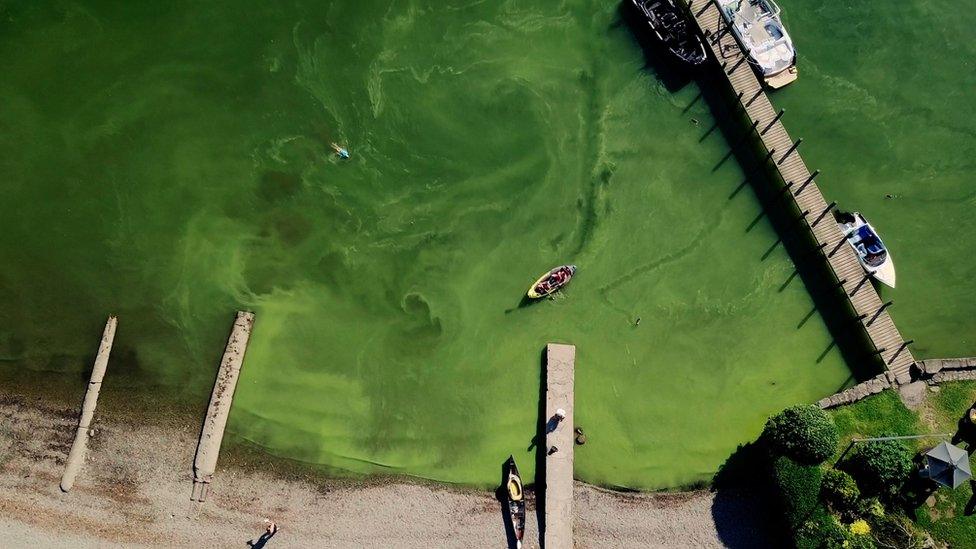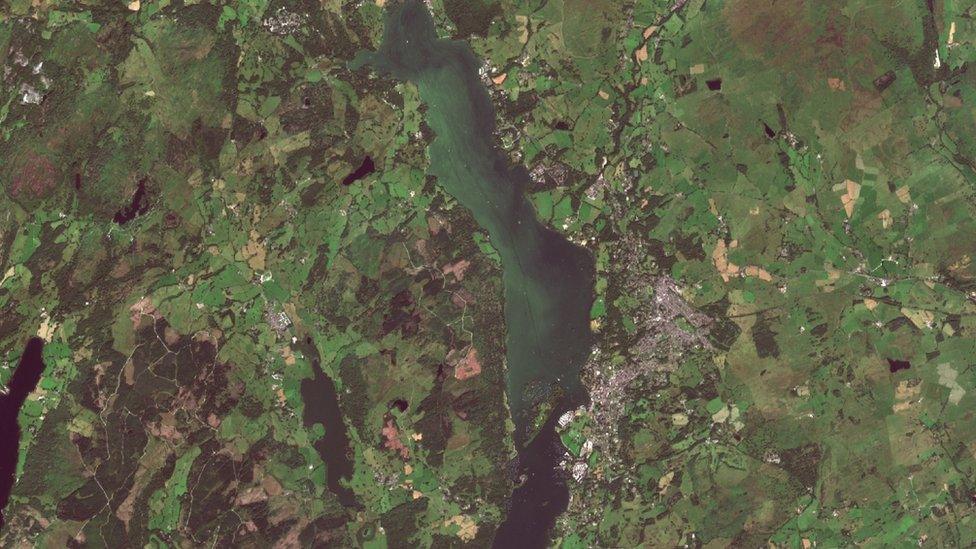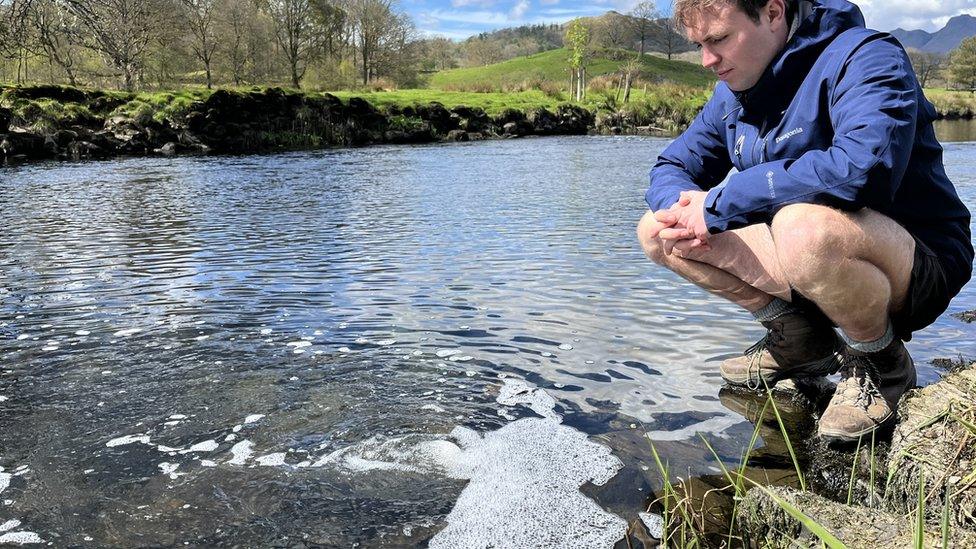Tourist influx turns Windermere green, researchers say
- Published
- comments

Algal blooming on Windermere in August 2022
High visitor numbers are turning one of Britain's most scenic lakes green, researchers say.
A report funded by the UK space agency suggests a link between peak tourist periods and algal blooming at Windermere in the Lake District.
Algal blooming is caused by warm temperatures and nutrients, and can make the water green and toxic.
Campaigners are linking the blooms to discharges of sewage, which although mostly treated, are nutrient-rich.
United Utilities, the local water company, insists its wastewater plants can cope with peak tourist periods.
Windermere is England's largest lake and one of the country's most popular natural attractions.
But in recent years, the normally clear water has been turning green due to algal blooming, particularly during the summer. Blooming is the rapid growth of algae and can lead to reduced oxygen levels in the water, killing fish and aquatic life.
Richard Flemmings from the environmental data company Map Impact, has been trying to work out why. He wanted to study whether the blooms are just the inevitable consequence of climate change and hotter, drier summers, or whether human discharges are also playing a role.
Both treated and untreated sewage discharges contain heightened levels of the key blooming nutrient phosphorus, from both human excrement and detergents.
"There is a significant correlation between visitor numbers and chlorophyll content," Mr Flemmings says.
Chlorophyll is the compound present in plants that gives them their green colour and so an indicator of algal concentration. With funding from the UK space agency, Map Impact used infrared analysis of satellite images to measure chlorophyll levels over the last five years in Lake Windermere, external.

Satellite images from August 2022 show the green blooming of Windermere (Image processed by Map Impact from ESA sensing data)
What makes Map Impact's work interesting is that it combined the chlorophyll analysis with mobile phone data.
This allowed it to estimate the number of people in the Windermere catchment area at any given time. This can vary widely from just 40,000 to 50,000 people when it's just residents, or up to 300,000 when you add tourists on a busy summer weekend.
"So what you see is typically you get a high spike in the number of people and then three to five days later you get a spike in chlorophyll in the lake," said Mr Flemmings.
Heat is one of the main drivers of algal blooming and though hot summer days are also likely to boost visitor numbers, Mr Flemmings says it has been possible to separate out the two factors.
"What we know is that algal blooms are in part caused by an increase in nutrients in the water and one of the contributors to nutrients is phosphorus which can come from human waste," he says.
The Environment Agency has done research suggesting that more than half of the phosphorus, external in Windermere comes from sewage. That includes sewage from overflows, United Utilities works, private sewage treatment facilities and septic tanks.
In November 2023, just 3% of the water samples collected from the lake's shoreline met minimum standards under UK legislation.

Campaigner Matt Staniek of Save Windermere looks at an outfall of treated effluent on the River Brathay
Matt Staniek from the Save Windermere campaign, says treated sewage from places like the Langdale Wastewater Treatment Plant are part of the problem. It has a permit to emit more than 1m litres a day of treated effluent into the River Brathay, which feeds into Windermere. There are other similar outflows around the catchment area, and while the wastewater treatment plants can remove some of the phosphorus, some of it is also flows out into the river.
"In the press there's a lot about untreated sewage," Mr Staniek says. "But in relation to Windermere and the ecological damage that's being inflicted upon our lake, the treated sewage is as much of a problem," he said.

The flow of treated effluent into the River Brathay which then flows into Windermere
Mr Staniek believes that when there are higher numbers of visitors, more treated sewage contributes to the algal blooming. He wants to see all sewage discharges diverted away from the Lake.
"Studies from all over the world demonstrate the exact same issues we're facing with Windermere," he said. "There is one solution that protects the lake forever, and that is to stop putting sewage in it."
United Utilities, the local water company, has carried out a feasibility study for what it calls a "discharge free" solution. But the miles of new sewage network that would be needed come with a hefty price tag.
The company denied its treated effluent might be behind the blooming.
"Our wastewater treatment works are sized to treat the sewage from maximum population numbers at peak times, and use the highest treatment standards including phosphorus removal and UV treatment to kill bacteria," a United Utilities spokesperson said.

Hotel owner Barney Cunliffe says the answer is more capacity to treat sewage
So what's going to give?
Barney Cunliffe runs the Michelin starred Gilpin Hotel near the lake and has joined with others in the hospitality industry to raise money for the Save Windermere campaign.
Mr Cunliffe says he's worried that if nothing changes there might be what he calls "a catastrophic event" on the horizon - a massive algal bloom that effectively kills the lake and deals a serious blow to tourism and the local economy. But he's adamant that the solution is better sewage treatment, not limits on tourist numbers.
"We can't be told you've got to stop growing because our waste isn't being treated properly," he says.
"We paid for that waste to be treated. We deserve to have that infrastructure in place to enable us to grow sustainably," he said.

Sign up for our Future Earth newsletter to get exclusive insight on the latest climate and environment news from the BBC's Climate Editor Justin Rowlatt, delivered to your inbox every Tuesday. If you are outside the UK, sign up to our international Future Earth newsletter here, external.